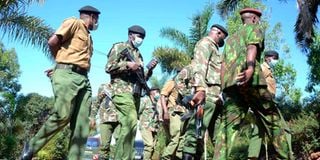
Deputy President William Ruto during a meeting with politicians allied to UDA at his Karen residence in Nairobi on August 5, 2021.
| File | Nation Media GroupNews
Premium
My life is in danger, DP Ruto tells police boss
Deputy President William Ruto yesterday said his life is in danger following the downgrading of his security detail, even as it emerged that the government might not yet be done with the changes it is instituting in his protection.
In a letter to Inspector-General of Police Hilary Mutyambai, Dr Ruto – who did not step out of his official Karen residence the whole day – said his new security detail might have been sent to his homes with ulterior motives.
The Nation learnt last evening that the National Police Service had earlier in the day moved some of its drivers attached to Dr Ruto.

An officer from GSU G Company opens the gate of DP Ruto’s official residence in Karen on August 26, 2021. The GSU officers are being replaced by those from AP Security of Government Buildings Unit.
At the same time, Kenya Prisons Service recalled some of its officers who had been seconded to the DP’s security detail.
Police spokesman Bruno Shioso did not respond to our questions on these new changes but Dr Ruto’s spokesman, Emmanuel Taalam, said there have been more developments to the security changes, which began on Thursday afternoon.
Though the extent of what is being viewed as a security downgrade for the DP is yet to be fully known, the switching of two drivers with new ones and the withdrawal of two Kenya Prisons Service officers has been interpreted by some as a sign of more things to come.
Even though the National Police Service said that the changes are routine, and that there are no punitive reasons, the Saturday Nation understands that the number of Administration Police (AP) officers manning the DP’s official residence in Karen, Nairobi, is smaller than that of the General Service Unit (GSU) personnel that have been stationed there since 2013.

Officers from the Administration Police Security of Government Buildings Unit (SGB) are shown around Deputy President William Ruto’s official residence in Karen after taking over security details from GSU guarding the residence in 2021.
Before Thursday, more than 70 GSU officers had been assigned to guard the DP’s official and private properties.
The DP also had dozens of close protection bodyguards, drivers from Kenya Prisons Service and an undisclosed number of AP officers to help in his errands.
Although Dr Ruto still remains the second most protected person in the country even after the withdrawal of the elite detail, he believes his life is threatened.
“What is the connection between the withdrawal of the GSU and the public statements of persons declaring that the Deputy President will not be there in 2022?” Dr Ruto asked through his chief of staff Ken Osinde to the letter sent on Thursday night.
“Is it the case that suspicious persons in AP uniform have been deployed at the residence with orders to facilitate sinister schemes against the Deputy President, which the withdrawn GSU refused to implement?”

An Administration Police Officer mans the entrance to Deputy President William Ruto’s home in Sugoi, Uasin Gishu County on August 26, 2021.
The Nation made a spot-check at the DP’s official Karen residence yesterday.
Our team saw nothing unusual at the address.
The AP officers from the Security of Government Buildings (SGB) regiment were already manning of the gates, which have been under the GSU G-Company (G-Coy).
The GSU are mandated through the National Police Standing Orders “to guard the President, the Deputy President and State Houses and Lodges”.
Military aircraft
The SGB, on the other hand, provides security to other government buildings, installations and institutions.
There was very little activity at the gates to the 10-acre property that houses Dr Ruto, and which has for several months been the venue of political meetings.
The only notable visitor to the house was Law Society of Kenya (LSK) president Nelson Havi.
Dr Ruto, who portrays himself as a staunch supporter of the Constitution, is against a push by President Uhuru Kenyatta to change certain clauses through the Building Bridges Initiative (BBI).
He celebrated the decisions of the High Court in May and last week’s judgment by the Court of Appeal.
However, his decision to openly challenge President Kenyatta, who asked him to resign, seems to have jolted the State machinery, which now appears determined to cut the DP down to size.
“He is a human being and we understand he is angry. That is normal, but he should not direct his anger at the Deputy President,” Soy MP Caleb Kositany said of the President.
“To those frustrating the Deputy President and his allies, we are Christians and we will not revenge. We have left it to God.”
Among the issues the State machinery is uncomfortable with is the continued hosting of delegations at the Ruto residence, where anti-government statements are issued.
State Houses and lodges fall under the management of State House Comptroller Kinuthia Mbugua.
The Deputy President is prevented from accessing his official residence in Mombasa. He was locked out in January 2020.
The DP does not use military planes or helicopters locally. He mostly flies in helicopters belonging to his company.
The President, and Orange Democratic Movement leader Raila Odinga use military aircraft.
While demanding an explanation from the IG about the events in the last two days, Dr Ruto accused Mr Mutyambai of failing to take his security seriously.
“This office will hold you responsible should harm befall the person of the Deputy President or any member of his family,” Dr Ruto’s office said.
“Given that the Deputy President is elected to perform duties of a constitutional office, any lapse in his personal security compromises the exercise of the functions of that office.”
See editorial here.





